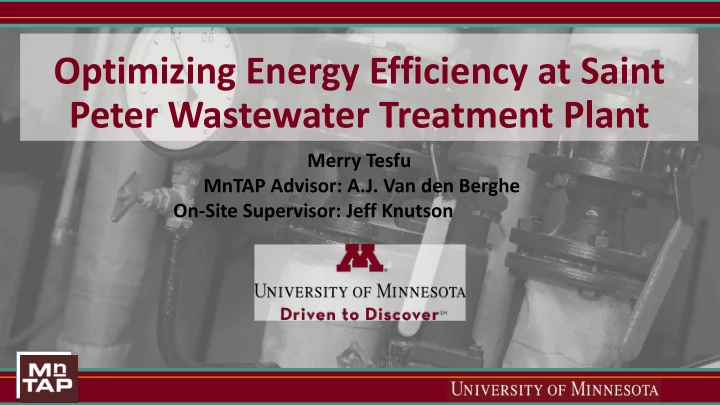

Optimizing Energy Efficiency at Saint Peter Wastewater Treatment Plant Merry Tesfu MnTAP Advisor: A.J. Van den Berghe On-Site Supervisor: Jeff Knutson
Facility Overview • Provides treatment of wastewater for the city of St. Peter to discharge into Minnesota River • Originally built in 1961 • Expanded in September 2000 • Designed flow rate: 4 million gallon per day (MGD) • Energy consumption: ~ 3 million kWh per year
Treatment Objective • Solids removal • Biochemical Oxygen Demand (BOD) removal • Total Suspended Solids (TSS) removal • Ammonia Nitrogen removal • Phosphorous removal • Pathogen removal
Motivations for Change Utility Costs vs. Water Treated (Major Utilities) $300,000 700 600 $250,000 Water Treated (MGAL) 500 $200,000 Cost ($) 400 $150,000 300 $100,000 200 $50,000 100 $0 0 2011 2012 2013 2014 2015 - 2015 Electric Cost $224,984 $230,590 $239,005 $237,205 $241,162 Natural Gas Cost $40,095 $24,566 $43,193 $59,063 $37,199 Water Treated 593 494 463 501 445 Year
Reasons for MnTAP Assistance • Identify energy usage of secondary treatment • Optimize aeration system by reduced Dissolved Oxygen (DO) • Determine whether the blower can handle the reduction • Optimize the biosolids blower • Make recommendations for reducing energy
Approach • Understand the facility’s current energy usage and operating methods • Use aeration model to quantify energy savings through reduced DO • Identify how Supervisory Control And Data Acquisition (SCADA) adjustments will impact the aeration energy consumption • Test for energy reduction recommendations that will insure wastewater treatment requirements
Top Electrical Energy Use Systems #1 SECONDARY TREATMENT #2 ODOR CONTROL 18% #3 SLUDGE HANDLING 26% 5% #4 INTERNAL PLANT PUMPING 2% #5 PRIMARY TREATMENT 9% 25% Balance of Plant Identified 15% Balance of Plant Unidentified Secondary Treatment 26% Biosolids Treatment 15%
Biological Aerated Filter (BAF) • Ammonia, Phosphorous, BOD, and TSS removal using bacteria • Bacteria require Dissolved Oxygen (DO) • Low DO can cause unwanted organisms to develop • High DO unnecessary for adequate treatment and does not further improve the quality of the effluent water
Blowers • 7 Positive displacement (PD) belt drive blowers: 50 HP each • Provide air for the BAF cells
SCADA Adjustment • BAF system controlled by SCADA • The number of cells in filtration determined by influent flow and target cell velocity • Reducing the target cell velocity from 2 gpm/ft 2 to 1 gpm/ft 2 to improve TSS removal at reduced cells • Allowing the number of cells in filtration to be determined by the influent flow • Result: Reduction in the average cells in filtration
SCADA Adjustment Energy Reduced Net Savings Implementation Payback Period Recommendation Status (per year) (per year) Cost (year) Alternative 1A 153,600 kWh $12,300 $0 Immediate Implemented SCADA Adjustment
DO Control System • Reducing the speed of the blower decreases the airflow • Reducing the speed decreases the power consumption Speed, Airflow & Power Relationship 𝑹 𝟐 = 𝑶 𝟐 Q = flow (cfm) 𝑹 𝟑 𝑶 𝟑 N = speed (RPM) 𝑸 𝟐 = 𝑶 𝟐 P = power (kW) 𝑸 𝟑 𝑶 𝟑
DO Control System Installing Variable Frequency Drive (VFD) • Reduce the blower speed from 1,682 RPM to 1,122 RPM • Reduced average effluent DO from 11 mg/L to 7 mg/L • Decrease the blower energy consumption by 25% Energy Reduced Net Savings Implementation Payback Period Recommendation Status (per year) (per year) Cost (year) Alternative 1B : 173,600 kWh $13,900 $27,200 2 Recommended Installing VFD
Combination of SCADA Adjustment and DO Control System • SCADA adjustment and installing VFDs • Decrease the blower energy consumption by 41% Energy Reduced Net Savings Implementation Payback Period Recommendation Status (per year) (per year) Cost (year) Alternative 1C combination of 289,600 kWh $23,200 $27,200 1.2 Recommended 1A & 1B
Biosolids Blower • Biosolids Blower: 100 HP consumes 407,200 kwh/year • Reducing the blower speed along with the liquid level by using VFD • Decrease the blower power consumption by 61% Energy Reduced Net Savings Implementation Payback Period Recommendation Status (per year) (per year) Cost (year) Opportunity 2: Installing VFD & 246,500 kWh $19,700 $18,000 0.9 Recommended controlling on tank level
Successful Process Changes Energy Implementation Net Savings Payback Recommendations Reduced Status Cost (per year) Period (year) (per year) Opportunity 1: Biological Aerated Filter Blower Efficiency 1A: SCADA 153,600 kWh N/A $12,300 Immediate Implemented Adjustment 1B: Installing VFD 173,600 kWh $27,200 $13,900 2 Recommended 1C: (1A &1B) SCADA Adjustment 289,600 kWh $27,200 $23,200 1.2 Recommended And Installing VFD Opportunity 2: Biosolids Storage Aeration Blower Efficiency Opportunity 2: 246,500 kWh $18,000 $19,700 0.9 Recommended Installing VFD
Potential Future Projects • To Model the aeration system with 5mg/L effluent DO Saving: 300,000 kWh/year, $25,000/year • To test the aeration system with 1.5 gpm/ft 2 target cell velocity and 7mg/L reduced effluent DO Saving: 400,000 kWh/year, $32,000/year • To optimize odor control system: consumes 25% of the total energy
Personal Benefits • Real-world engineering experience • Understanding in process control of wastewater treatment • Equipment energy usage and optimization • Communication skills • Small town life experience
Questions? This project was sponsored in part by the Southern Minnesota Municipal Power Agency
Recommend
More recommend